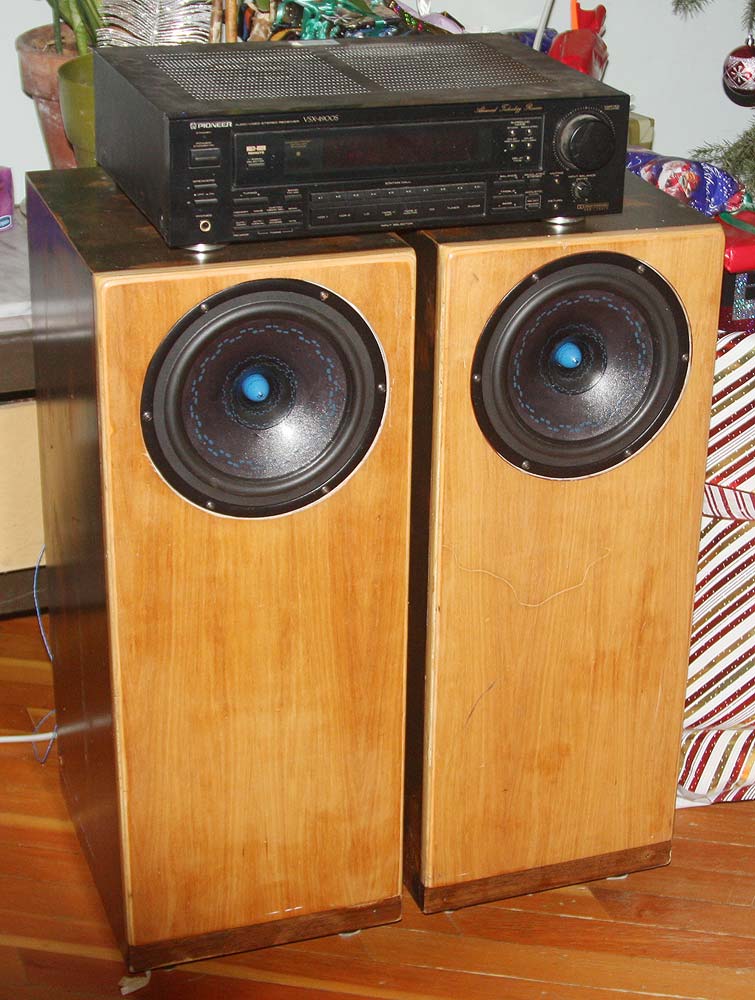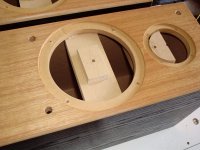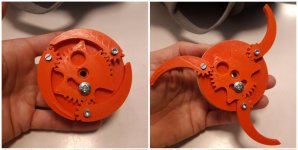I have some old speaker cabinets that have rebated driver mounting holes - these are old subwoofer cabinets. I have several drivers that would work in these cabs but the driver frame OD is a few mm too large to sit in the recess. I would very like to use these drivers and cabs together, so I am looking for ideas to either:
(a) use something like a Dremel tool to grind/sand the rebate edge, going round and round while sanding, until wide enough. I am concerned that I might not be able to sand the very bottom of the rebate sidewall, or I might damage the veneer on the face by doing this.
or
(b) forget about the rebate - create a ring of wood to fill it in and mount the driver with its frame proud of the cabinet face. This would waste a lot of material, but would not require sanding.
Any other ideas? Advice?
(a) use something like a Dremel tool to grind/sand the rebate edge, going round and round while sanding, until wide enough. I am concerned that I might not be able to sand the very bottom of the rebate sidewall, or I might damage the veneer on the face by doing this.
or
(b) forget about the rebate - create a ring of wood to fill it in and mount the driver with its frame proud of the cabinet face. This would waste a lot of material, but would not require sanding.
Any other ideas? Advice?
Maybe another approach would be to attach a circular piece of wood. Then find the exact center (how?) and drill a pilot hole for my plunge router and use my circle cutting jig to trim off additional material from the inside of the rebate. That actually might work well, as long as I can find the exact center of the hole. How to do that?
I had a similar challenge and addressed it with one of these kits:
https://www.mlcswoodworking.com/sho...l/pages/bit_rabbet.html?zoom_highlight=rabbet
https://www.mlcswoodworking.com/sho...l/pages/bit_rabbet.html?zoom_highlight=rabbet
Small router freehand, the woodworkers would likely come up with a jig to make it perfect.
A big *** rasp works well, if crud, at exapanding the actual hole.
dave
A big *** rasp works well, if crud, at exapanding the actual hole.
dave
If I can find the right diameter for my needs that would be a relatively straightforward way to do it. THanks!I had a similar challenge and addressed it with one of these kits:
https://www.mlcswoodworking.com/sho...l/pages/bit_rabbet.html?zoom_highlight=rabbet
It's a rebated hole
I understood, i have dealt with the same before. My trusty little Rockwell Router. Closer to a veneer router than a plunge router.
These for instance:

dave
I know the Greeks had a thing. There is of course a lathe-worker tool to do just this. (Two fences at 90 and a slot or blade at 45. "Center finder")find the exact center of the hole. How to do that?
With a compass: set dividers to what looks like a little more than half-way. Set point on rim and mark arc near center with pencil. Go part-way around circle, do it again, and then again-again so you have a 3-arc "triangle" penciled on. If the triangle is too big to eyeball center, use it to guide a smaller compass span. The mathematician says it will never be exact, the engineer says it can be close-enough.
Without a compass, use a strip of paper. Mark the diameter. Fold in half. Mark the center, turn 90 degrees, mark again, then check at 180 and 270 deg.
If you have a whole sheet of paper you can trace the circle and fold in half, once each way.
Put a thumb-tack point-up and balance your circle of wood. (depends on uniform density; heavy cardboard or plastic sheet may be gooder though most building-wood is fairly uniform)
I've done this heaps of times and as stated above all you need is a compass and a ruler. I just glue in a piece in the hole with a block to the same level as the baffle (see the pic). Once marked out drill the hole for the router jig and machine as required.
Attachments
Cut a circular hole of the right diameter in ply with the router trammel.
Clamp to the cabinet and use as a jig with a bearing bit in the router.
Has the advantage the jig protects the surface of the cabinet and it's almost impossible to slip and ruin the workpiece.
Clamp to the cabinet and use as a jig with a bearing bit in the router.
Has the advantage the jig protects the surface of the cabinet and it's almost impossible to slip and ruin the workpiece.
Yes, that is exactly what I plan to do. I need to use a board on top of the cabinet both to provide a wider area on which I can stabilize the router, and because there are existing grille mounts that protrude slightly above the face of the cabinet that would cause the router to stop or hang up, or even potentially tilt slightly. I ordered a rabbeting router bit of the proper depth so that I can open up the rebate enough for the driver to sit inside properly. Once the weather has improved (I do not have a heated work space) I can give it a try.
- Home
- Design & Build
- Construction Tips
- HELP: need advice on how to widen driver mounting hole rebate

